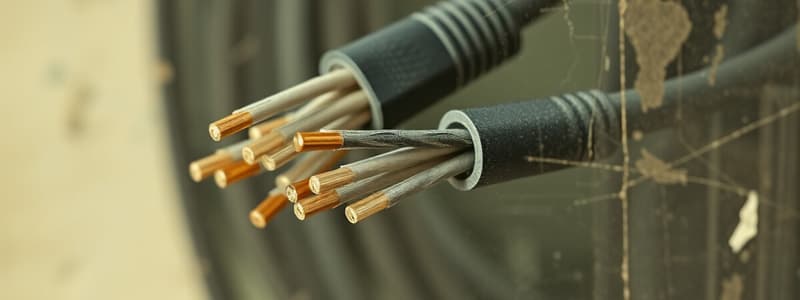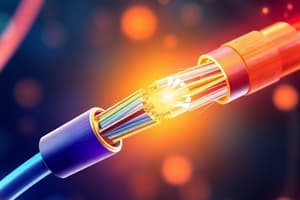Podcast
Questions and Answers
What is a key benefit of twisting the wire pairs in twisted pair cabling?
What is a key benefit of twisting the wire pairs in twisted pair cabling?
- To increase the length of the cable
- To enhance the aesthetic appeal
- To physically strengthen the wires
- To reduce electromagnetic interference (correct)
Which type of twisted pair cable is less expensive and easier to work with?
Which type of twisted pair cable is less expensive and easier to work with?
- Fiber optic cable
- Unshielded twisted pair (UTP) (correct)
- Shielded twisted pair (STP)
- Coaxial cable
What is one disadvantage of twisted pair cables?
What is one disadvantage of twisted pair cables?
- They have very high bandwidth
- They are susceptible to interference (correct)
- They are more durable than coaxial cables
- They are resistant to eavesdropping
What is the main difference between shielded twisted pair (STP) and unshielded twisted pair (UTP)?
What is the main difference between shielded twisted pair (STP) and unshielded twisted pair (UTP)?
What is the maximum speed supported by Cat 5 twisted pair cable?
What is the maximum speed supported by Cat 5 twisted pair cable?
Which of the following wiring standards is NOT commonly used in twisted pair cabling?
Which of the following wiring standards is NOT commonly used in twisted pair cabling?
What is a characteristic of higher numbered twisted pair cable categories?
What is a characteristic of higher numbered twisted pair cable categories?
What type of connector does Cat 5 twisted pair cable typically use?
What type of connector does Cat 5 twisted pair cable typically use?
Which category of UTP cable supports gigabit Ethernet and is similar to Cat 5 but provides better EMI protection?
Which category of UTP cable supports gigabit Ethernet and is similar to Cat 5 but provides better EMI protection?
What is the maximum length for Cat 6 cables to maintain a 10 Gbps speed?
What is the maximum length for Cat 6 cables to maintain a 10 Gbps speed?
Which category of cable offers exceptional noise immunity and has the strictest specifications for crosstalk and noise?
Which category of cable offers exceptional noise immunity and has the strictest specifications for crosstalk and noise?
Which type of twisted pair cable is designed for direct burial in the ground?
Which type of twisted pair cable is designed for direct burial in the ground?
Which cable type is suitable for use where flexibility and frequent movement are needed?
Which cable type is suitable for use where flexibility and frequent movement are needed?
Which category of cable is rated for data transfers 400 times faster than Cat 5?
Which category of cable is rated for data transfers 400 times faster than Cat 5?
What type of cable meets rigorous fire safety standards for installation in plenum spaces?
What type of cable meets rigorous fire safety standards for installation in plenum spaces?
Which cable category is limited to connecting devices less than 100 meters apart for optimal 10 Gbps performance?
Which cable category is limited to connecting devices less than 100 meters apart for optimal 10 Gbps performance?
Flashcards
Twisted Pair Cable Components
Twisted Pair Cable Components
Twisted pair cables consist of four pairs of copper wires, each pair twisted together. Each wire transmits a signal (positive or negative), and the twisting reduces interference. PVC insulation covers each wire, and an outer sheath protects the entire bundle.
Twisted Pair Cable Interference Reduction
Twisted Pair Cable Interference Reduction
Twisting the wires in pairs minimizes electromagnetic interference (EMI) and crosstalk.
UTP vs. STP
UTP vs. STP
Unshielded Twisted Pair (UTP) cable has only an outer plastic sheath; Shielded Twisted Pair (STP) has a grounded copper shield around the wires. STP offers better EMI protection but is more expensive than UTP.
T568A/T568B
T568A/T568B
Signup and view all the flashcards
Twisted Pair Cable Advantages
Twisted Pair Cable Advantages
Signup and view all the flashcards
Twisted Pair Cable Disadvantages
Twisted Pair Cable Disadvantages
Signup and view all the flashcards
Twisted Pair Cable Categories
Twisted Pair Cable Categories
Signup and view all the flashcards
Category 5 (Cat5) Cable
Category 5 (Cat5) Cable
Signup and view all the flashcards
Cat 5e UTP Cable
Cat 5e UTP Cable
Signup and view all the flashcards
Cat 6 UTP Cable
Cat 6 UTP Cable
Signup and view all the flashcards
Cat 6a UTP Cable
Cat 6a UTP Cable
Signup and view all the flashcards
Plenum Cable
Plenum Cable
Signup and view all the flashcards
Direct Burial Cable
Direct Burial Cable
Signup and view all the flashcards
General Purpose UTP Cable
General Purpose UTP Cable
Signup and view all the flashcards
UTP Cable Substitution
UTP Cable Substitution
Signup and view all the flashcards
RJ45 Connector
RJ45 Connector
Signup and view all the flashcards
Study Notes
Twisted Pair Cable Overview
- Twisted pair cabling reduces signal interference and supports modern network standards.
- Composed of copper wires twisted in pairs, insulated with PVC, and bundled in an outer sheath.
- Unshielded twisted pair (UTP) is less expensive and easier to work with.
- Shielded twisted pair (STP) offers better EMI protection but is more expensive.
- T568A and T568B are wiring standards defining RJ45 connector wire order.
Twisted Pair Cable Comparison
- Advantages: Inexpensive, easy installation, flexible, lightweight, common medium.
- Disadvantages: Susceptible to interference, damage, and eavesdropping; low bandwidth.
Twisted Pair Cable Categories
- Cable categories differ electrically, not physically. Higher categories support faster speeds due to different wire gauges and twists per inch.
- Phone cable (RJ11): Two pairs (4 wires), used for dial-up.
- Cat 5: Supports 100 Mbps Ethernet, uses RJ45.
- Cat 5e: Improved EMI protection, supports Gigabit Ethernet, uses RJ45.
- Cat 6: Supports 10 Gbps (limited to 55m), uses RJ45.
- Cat 6a: Supports 10 Gbps (limited to 100m), improved shielding, uses RJ45.
- Cat 7: Supports 10 Gbps, shielded, strictest crosstalk specs, uses RJ45.
- Cat 7a: Supports 10 Gbps, shielded, exceptional noise immunity, strictest crosstalk specs, uses RJ45.
- Cat 8.1: Supports 25 Gbps, shielded, uses RJ45 for Class I, non-RJ45 for Class II.
- Cat 8.2: Supports 40 Gbps, shielded, uses RJ45 for Class I, non-RJ45 for Class II.
- Use a special crimping tool for connectors.
- Substitution rule: Cat X can be substituted for any category below X, but not above it.
- Cable cores: Solid core for long runs, stranded core for flexible drop cables.
Twisted Pair Cable Ratings
- Direct Burial: Designed for direct burial in the ground; no extra protection needed.
- General: Minimum requirement for commercial installations, meets UL-1518, and vertical flame test standards. High toxicity during burning.
- Plenum: Used in plenum spaces (air circulation areas). Flame retardant, non-toxic plastics, meets NFPA-262 and 90A standards.
- Riser: Used in vertical shafts between floors; withstands fire propagation, UL-1666 tested. Tested while mounted vertically.
Studying That Suits You
Use AI to generate personalized quizzes and flashcards to suit your learning preferences.




